
19 minute read
CULTURAL TIDBITS: Fun Facts
Fun Facts About Christmas
By Lina Zhu
Advertisement
“Jingle Bells” was written for Thanksgiving, not Christmas.
The song was written in 1857 by James lord Pierpont and published under the title “one Horse open Sleigh.” It was supposed to be played in the composer’s Sunday school class during Thanksgiving as a way to commemorate the famous Medford sleigh races. “Jingle Bells” was also the first song to be broadcast from space.
Two weeks before Christmas is one of the two most popular times for couples to break up.
According to data analyzed from Facebook posts and statuses, couples are more likely to end their relationship two weeks before Christmas and two weeks after Valentine’s Day. Christmas Day, however, is the least favorite day for breakups.
December 25.
While Christmas celebrates the birth of Jesus Christ, there is no mention of December 25 in the Bible. In fact, most historians assume that Jesus was born in the spring. And his birthday itself didn’t become an official holiday until the third century. Some historians believe the date was actually chosen because it coincided with the pagan festival Saturnalia, a celebration in honor of the agricultural god Saturn.
Hanging stockings started by accident.
According to legend, we hang stockings up by our chimney, thanks to a poor man who did not have enough money to buy dowries for his three daughters. Generous old St. Nick dropped a bag of gold down their chimney, where the girls hung their stockings to dry. That’s where the gold ended up, and the
Christmas wasn’t always on
tradition began.
Celebrating Christmas used to be illegal.
When the Pilgrims settled in Boston, the celebration of Christmas had been outlawed. From 1659 to 1681, anyone caught making merry would face a fine for celebrating. After the revolutionary War, this day became so important that Congress even held its first session on December 25, 1789. Christmas was not declared a federal holiday for the next century.


Christmas decorating sends nearly 15,000 people to the ER.
If you’ve seen Clark Griswold decorate his house over the Christmas holidays, you probably won’t be surprised. In fact, the Consumer Product Safety Commission estimates that 14,700 people visit hospital emergency rooms each November and December for holiday renovations, so be careful when getting on your ladder.
Do Asian Countries Celebrate Christmas?
Japan | The major religions in Japan are Buddhism and Shinto. less than two percent of Japanese claim to be Christians so Christmas is more of a commercial event that Japanese people celebrate for fun. It is common for Japanese parents to give Christmas presents to their children at Christmas. Corporate offices and malls are sometimes decorated for the occasion.

South Korea | Christmas is more widely celebrated in South Korea, as Christians make up about 30 percent of the population. However, another 70 percent of South Koreans are Buddhist (about 25 percent) or have no religious affiliation, so if they celebrate Christmas, it’s more for the joyous sentiment the holidays bring. unlike In Japan, Christmas is an official public holiday in South Korea, but Koreans still need to go to work or school on Boxing Day, the 26th. one of the biggest differences between South Korean and Western Christmas celebrations is the food. Koreans typically celebrate it by eating more traditional dishes. The Philippines | More than 90 percent of Filipinos are roman Catholic, making the Philippines one of two predominantly Christian countries in Southeast Asia (East Timor is the other). Christmas is celebrated publicly throughout the country, aside from a handful of places where Islam is the predominant faith. As for the rest of the country, a strong emphasis on religion can be seen during the Christmas holiday. You’ll even hear Christmas songs being played in october as the country gears up for one of its favorite holidays!

China | In China, only about one percent of people are Christians, so most people only know a few things about Christmas. Because of this, Christmas is only often celebrated in major cities. Christmas is not an official holiday in China, so most offices, schools, and shops remain open. Although it is not an official holiday, Chinese people still get in the holiday spirit around the 25th of December just for fun. During Christmas time, there are Christmas trees, lights, and other decorations on the streets and in department stores.
Vietnam
Known in Vietnam as Noel, Christ- Midnight Mass. There are also French mas is one of the major festivals in the influences in the Christmas traditions country, celebrated with much fanfare from years of French colonial rule. by all religious communities. Despite In Ho Chi Minh City, Vietnam’s the fact that Buddhism is the domi- largest city, people like to go into the nant religion and Christians form only city center on Christmas Eve to enjoy a minority, the people love celebrating the light shows and decorations, eat the spirit of Christmas, predominantly out, throw confetti, and take pictures. on Christmas Eve when they attend a Children in Vietnam love Santa Claus.
Kazu Oba, a potter and sculptor based in Boulder, Colo. was born in Kobe, Japan. He was inspired to travel on his own and live in the U.S. after watching the American movie “Grease” in 1989. He then dropped out of high school in Japan and attended Gilpin County High School in Colorado and graduated in 1990.
Oba worked in restaurants for about 15 years. During his time, he became increasingly interested in the vessels for the food he was serving in the restaurants. While studying at the University of Colorado Boulder, Oba apprenticed under Jerry Wingren, a sculptor in stone and wood for four years.
He then decided to go back to Japan to study under one of the world’s most renowned potters in Karatsu (one of the ceramic centers in Japan), Takashi Nakazato. After his training in Japan, he returned to Colorado in 2004 and eventually started his own studio, O’baware, creating ceramics and sculptures with his wife, Yuka.
KAZU

By Lina Zhu
What does the process of making an O’baware look like?
Location: 1061 Mercury Drive, Lafayette, CO 80026 Website/Online Shop: www.obaware.com Follow on Instagram: @oba_ware
Each o’baware is made by our hands one piece at a es of bowls for his ramen while he was in search of a restautime to bring out the natural curves and the warm textures rant location. that only handmade He initially wanted pottery can bring. Kazu’s pottery is dedicated to functional, deeper bowls for his They may be slight- everyday ware to be used in the home. His Shoyu and Miso ramen ly odd shaped and background as a chef distinctly influences that have more broth, irregular, just like us, but that’s a part of the his work, as he maintains a constant focus and shallow but wider bowls for his signature beauty. on the relationship between his pots and the ramen Star ramen.
The process of food that will occupy them. Now he serves all hot making an o’baware ramen in the deeper always starts with a need for that particular vessel. For ex- bowls and uses the wide and shallow bowls for his cold ample, Takashi, owner of ramen Star (located in Denver), ramen. The shape of the bowls were made to meet their and I spent four years trying many different shapes and siz- function.
“My work and designs come out of my lifestyle, a Japanese living in the western world, a family with a small child, surviving through Covid. My pots are about all those things.
- Kazu Oba
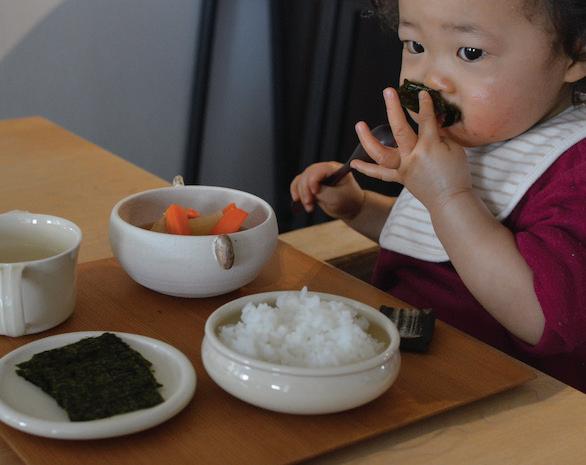

KAZU OBA

How have things changed for you since becoming a parent?
I never made dishes for babies before but now have created various versions as my daughter Maya* is getting bigger. She is still tiny, but as she learns to use different utensils like chopsticks and to interact with vessels differently, I’m making bowls and plates with different features.
How does your work represent your own identities, cultures, and ideologies?
My table and chairs at home make it a lot more comfortable to use dishes in Japanese fashion (lifting various vessels off the tabletop) because my chairs are two inches higher than the standard height, so my forearms don’t come in contact with the tabletop. The standard height tables and chairs are in fact made for a dining experience where all the dishes are left on the table. This includes Chinese and Korean table etiquettes.
Many of the tools and techniques I use in the studio required years in development, but the final products often take a few minutes, if not seconds to produce. I view pottery making as calligraphy. We spend our lifetime perfecting the simple gestures, with the least amount of fussing at the potter’s wheel. I believe the pots made in the simplest and quickest fashion are the healthiest and most honest dishes.
How has your business been affected by the pandemic?
Most of my shows this year got canceled, starting with a show in New York in March and one in Tokyo in April along with two others in Japan this summer. A local event that was planned for this spring is now happening at The Source. An all-wood sculpture show at Arvada Center, which was planned for this fall, is taking place in January.
Although many events were canceled due to COVID-19, Kazu Oba is arranging future events to showcase his works and exchange ideas. Connect with him and find out more about O’baware’s events on their website (obaware.com) and social media (@oba_ware).
2020 ELECTION
results
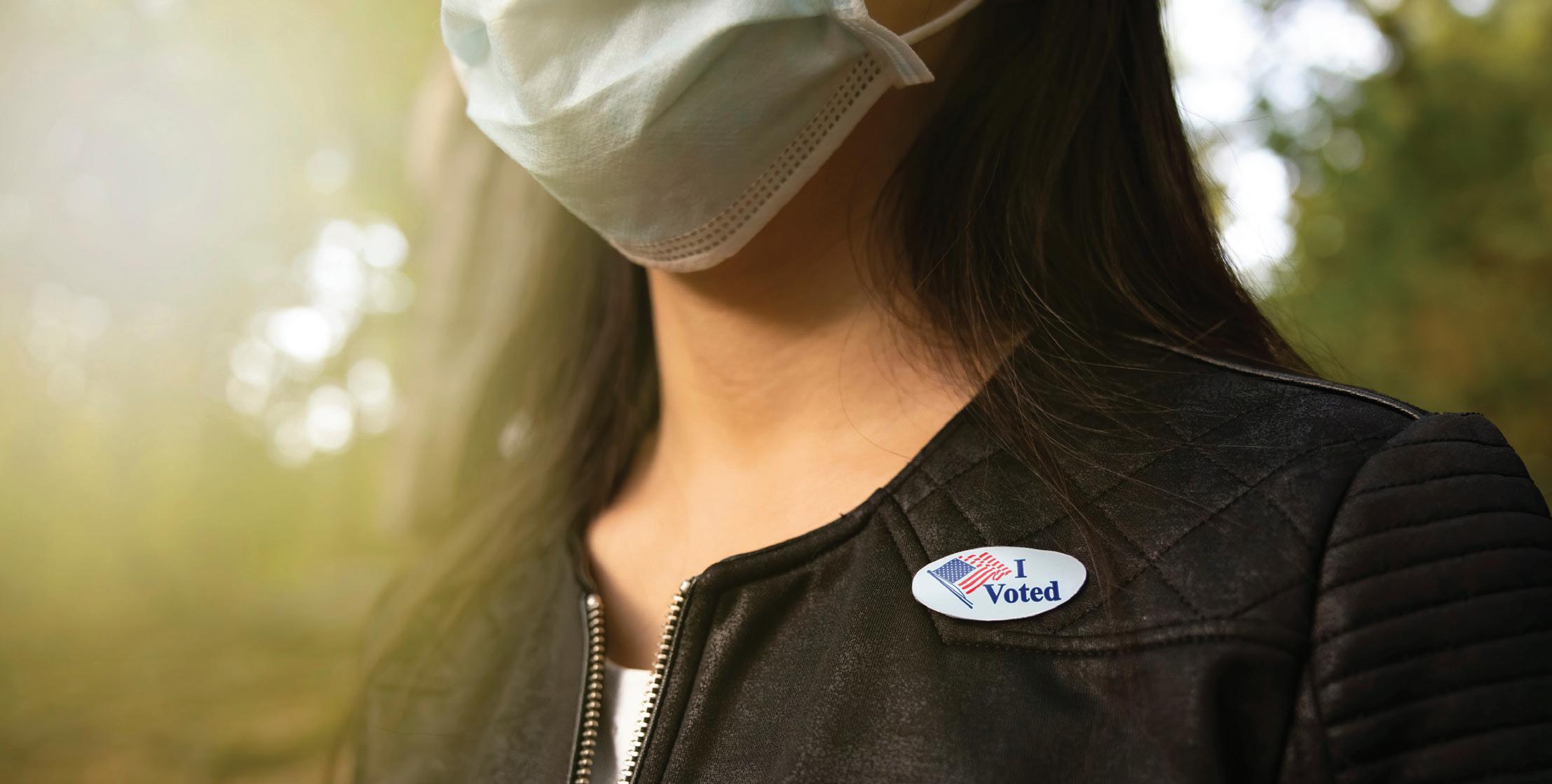
AAPIs are the fastest-growing segment of eligible voters. More than 11 million were able to vote this year, making up nearly 5% of the nation’s eligible voters. AAPIs are the only major racial/ethnic group in which naturalized citizens – rather than the U.S. born – make up a majority of eligible voters.
Source: Pew Research Center
Election Day is behind us. All eyes are now on the georgia’s Senate runoffs in January, in which AAPI voters may play a pivotal role. Rounding out the 2020 election, top AAPI voter concerns were the economy (favoring Republicans), healthcare, education, and racial discrimination (all other three concerns favoring Democrats). And despite significant diversity in socioeconomic status and ethnic background, AAPIs showed solidarity on issues of inclusion, social safety net, and economic justice.
Of Asian American voters: 63% voted for Biden
31% voted for Trump
Source: NBC News Exit Poll
“Asian Americans have been distinct from the general U.S. public when it comes to progressive views on health care, the environment, gun control and a social safety net provided by the government. These issue positions have propelled Asian Americans toward the Democratic presidential candidate for the past seven election cycles.”
Comprised of more than 20 different ethnicities, AAPI voters’ alignment with the political parties varies significantly, with a high proportion of AAPI voters identifying as unaffiliated. As seen below, Vietnamese Americans were more likely to vote for Trump (with 42% identifying as Republican). By contrast, Indian Americans were more likely to vote for Biden (with 50% identifying as Democrats).

AAPI voters are dispersed throughout the country, but more than half live in only three states. California holds 35% of the U.S. Asian electorate (3.6 million), followed by New York (920,000) and Texas (698,000).
ALEx LEE, made history in multiple ways when he won California’s 25th District Assembly race. At 25, he’ll become California’s youngest Asian American state legislator ever, the first openly bisexual state legislator and the first assembly member from generation Z.
The district, which encompasses Fremont, Santa Clara, and San Jose, in East Bay and Silicon Valley, is one of the heaviest Asian state legislative districts in the state. Lee’s parents are immigrants from Hong Kong. NIKIL SAVAL has become the first South Asian American elected to Pennsylvania’s state Senate. Elected to represent Philadelphia’s diverse District 1, Saval was co-editor-in-chief of the literary magazine n+1, where he prioritied coverage of issues like social justice and labor unions. Saval, 37, went to Columbia University and received a Ph.D. in English from Stanford. His parents emigrated from Bangalore, India, to New Mexico in 1970 before settling in Los Angeles. They ran a pizza restaurant that primarily employed immigrants of all statuses.
mARILYN STRICKLAND
won the open seat in Washington’s 10th Congressional District. She previously served as the 38th Mayor of Tacoma from 2010 to 2018.

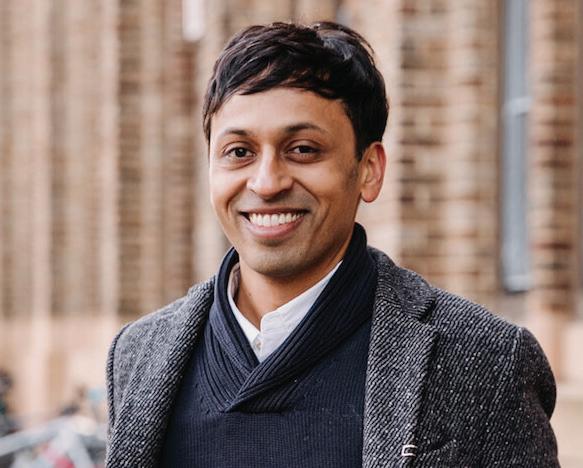
Strickland will be among the first Korean American women elected to Congress, and she will be the first member of Congress who is of both Korean and African American heritage. Strickland was born in Seoul; her father, a veteran of World War II and the Korean war, met her mother while stationed there.
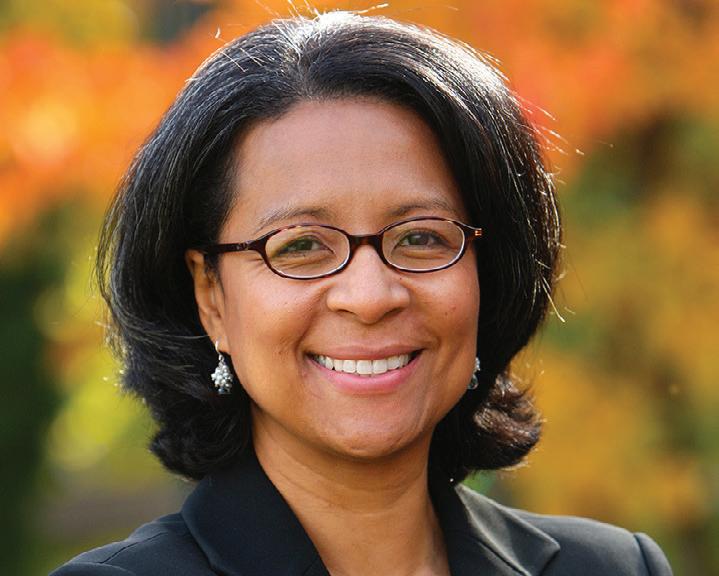
KESHA RAm made history when she became the first woman of color to be elected to the Vermont Senate in a state that’s more than 94 percent white. In her early career, she was the youngest member of the House of Representatives and the youngest legislator serving at the time. She is still the youngest Indian American to ever serve in state elected office. Ram, the daughter of an Indian immigrant father and a Jewish mother, said her parents’ experiences deeply influence the way she thinks government can affect people’s lives. ADRIAN TAm, a 28-year-old Asian American defeated a leader of the Hawaii chapter of the Proud Boys, a far-right extremist group, to become the only openly LgBTQ person in Hawaii’s Legislature. Tam, a first-time candidate, took 63 percent of the vote against Nicholas Ochs.
Tam was born to immigrants from Hong Kong and Taiwan. He graduated with a degree in history from Pennsylvania State University, and upon returning to Hawaii, began working for his family’s real estate company. Two Indian Americans were elected to the New York State Assembly — making them the first South Asians voted into the lower house of the state Legislature. Both Democrats, JENIFER RAJKumAR and ZOHRAN mAmDANI won by 66 percent and 72 percent of votes respectively. Mamdani (left), 29, is a housing advocate, who was born and raised in Uganda. Rajkumar, 38, is an Indian American lawyer who served as gov. Andrew Cuomo’s director of immigration affairs.



Taiwan is crucial to the global fight against cybercrime
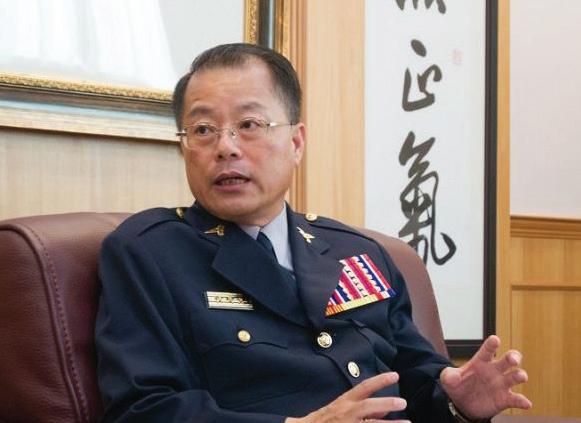
According to World Health organization statistics, as of September 30, 2020, there were more than 33.2 million confirmed CoVID-19 cases and more than 1 million related deaths worldwide. Having experienced and fought the SArS epidemic in 2003, Taiwan made advance preparations in the face of CoVID-19, conducting early onboard screening of inbound travelers, taking stock of antipandemic supply inventories, and forming a national mask production team. The government’s swift response and the Taiwanese people’s cooperation helped effectively contain the spread of the disease.
The international community has been putting its resources into fighting CoVID-19 in the physical world, yet the cyberworld has also been under attack, and faces major challenges. The Cyber Attack Trends: 2020 Mid-Year report published in August 2020 by Check Point Software Technologies ltd., a well-known IT security company, pointed out that CoVID-19 related phishing and malware attacks increased dramatically from below 5,000 per week in February to over 200,000 in late April.
At the same time as CoVID-19 has seriously affected people’s lives and safety, cybercrime is undermining national security, business operations, and the security of personal information and property, causing significant damage and losses. Taiwan’s success in containing CoVID-19 has won worldwide acclaim. Faced with cyberthreats and related challenges, Taiwan has actively promoted policies built around the concept that information security is national security. It has bolstered efforts to train IT security specialists and develop the IT security industry and innovative technologies. Taiwan’s national teams are ever present when it comes to disease or cybercrime prevention. freedom this provides to conceal their identities and engage in illegal activities.
The Taiwanese police force has a special unit for investigating technology crimes comprising professional cybercrime investigators. Cybercrime knows no borders, so Taiwan hopes to work with the rest of the world in jointly fighting the problem.
With state-sponsored hacking rampant, intelligence sharing is essential to Taiwan.
Every month, Taiwan’s public sector experiences an extremely high number of cyberattacks from beyond Taiwan’s borders—between 20 and 40 million instances. Being the priority target of state-sponsored attacks, Taiwan has been able to track their sources and methods and the malware used. By sharing intelligence, Taiwan could help other countries avert potential threats and facilitate the establishment of a joint security mechanism to counter state cyberthreat actors.
Additionally, given that hackers often use command-and-control servers to set breakpoints and thus evade investigation, international cooperation is essential for piecing together a comprehensive picture of chains of attack.
In the fight against cybercrime, Taiwan can help.
At the invitation of the European union Agency for law Enforcement Cooperation (Europol), Taiwan’s Criminal Investigation Bureau (CIB) visited its office to exchange intelligence
By Huang ming-chao
Commissioner Criminal Investigation Bureau Ministry of the Interior
Republic of China (Taiwan)
and evidence. The two entities established operation TAIEX. under this plan, the CIB provided key evidence retrieved from suspects’ mobile phones to Europol, which sieved through the evidence and identified the suspected mastermind, known as Dennys, who was then based in Spain, which led to his arrest by Europol and the Spanish police.
The fight against cybercrime requires international cooperation, and Taiwan must work together with other countries. Taiwan can help these other countries, and is willing to share its experiences so as to make cyberspace safer and realize a truly borderless internet. I ask that you support Taiwan’s participation in the annual INTErPol General Assembly as an observer, as well as INTErPol meetings, mechanisms, and training activities. By voicing your backing for Taiwan in international forums, you can play a critical role in advancing Taiwan’s objective of taking part in international organizations in a pragmatic and meaningful manner. In the fight against cybercrime, Taiwan can help!
Cybercrime knows no borders; Taiwan seeks cross-border cooperation
Nations around the globe are fighting the widely condemned dissemination of child pornography, infringements on intellectual property rights, and the theft of trade secrets. Business email fraud and ransomware have also generated heavy financial losses among enterprises, while cryptocurrencies have become an avenue for criminal transactions and money laundering. Since anyone with online access can connect to any internet-enabled device in the world, crime syndicates are exploiting the anonymity and


Takayama, Japan, spotlighted in Culture Day Zoom event
The Denver Takayama Sister City Committee (DTSCC) held its third annual Bunka No Hi, or Japan Culture Day, on November 7. one positive side-effect of the Covid-19 pandemic and the cancellation of in-person events is that people from families and friends to organizations have gotten used to meeting virtually using zoom.
Takayama, nestled in the mountainous region of Gifu prefecture in central Japan, is known for its local cuisine including its seasonal mountain vegetables and high-grade “Hida Beef,” as well as its history as a center of traditional carpentry, woodworking and lacquerware, and a traditional “old Town” district with shops and homes that were built hundreds of years ago.
Takayama is Denver’s second-longest-lasting Sister City – the relationship was started 60 years ago, with exchange trips of students and adult groups. And events throughout the year. over 140 people logged on for the event, which began with a welcome message from Midori Takeuchi, the Consul General of Japan in Denver. The first portion of the event featured a virtual walking tour video of Takayama’s old Town district, with tour guide Mika Shiraishi explaining the video and answering viewers’ questions live. There was a brief break featuring a video of students from Hie Junior High School performing rajio Taiso (“radio Exercise”), a daily broadcast of stretching exercises that millions of Japanese have done every morning for decades. The second half of the livestream was a cooking demonstration of Takayama specialties on a traditional grill. A Q&A session followed. The event succeeded at introducing viewers to Takayama and the city’s culture and educating Denver audiences about a part of Japan that isn’t on the usual tourist itineraries, but should be.



Written by: Gil Asakawa, Chair of the Denver Takayama Sister City Committee





Bilingual in Vietnamese
LISANGUYENREMAX.COM LISA NGUYEN



143 Union Blvd. Suite #120 Lakewood, CO 80228 Direct: 303-985-4555 Cell: 303-669-5255
lisanguyen@remax.net
ADVERTISE WITH US IN ASIAN AVENUE MAGAZINE



WITH VARIOUS AD SIZES AND FLEXIBLE FREQUENCY, WE CAN WORK WITH YOUR BUDGET.




Contact Asian Avenue magazine at asianavemag@gmail.com or 303.937.6888 for advertising opportunities.




